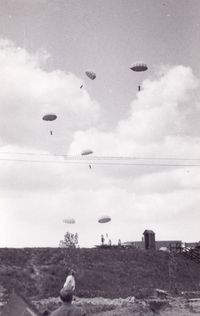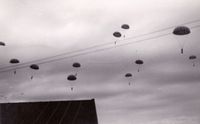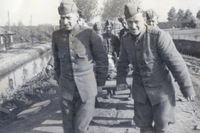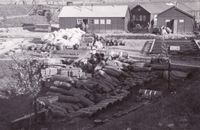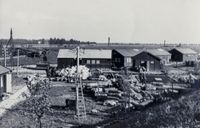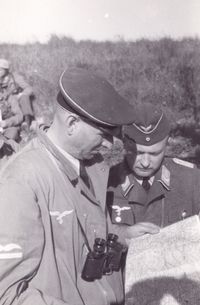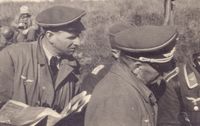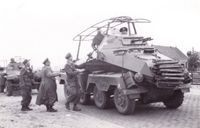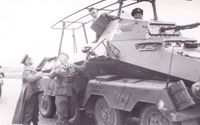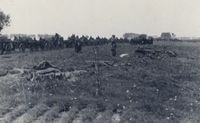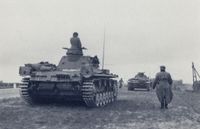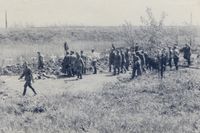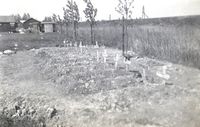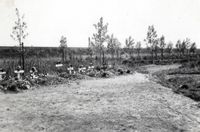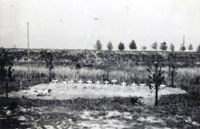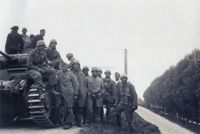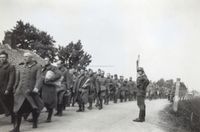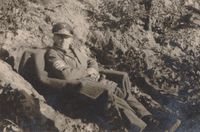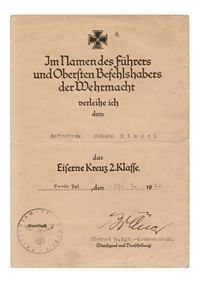The Tweede Tol - May 1940.
In the early morning of May 10, 1940, Dutch soldiers at the Tweede Tol were awakened by the sound of aircraft flying overhead. Soon, paratroopers started jumping out of the planes. The objective of these airdrops was to capture the crucial bridges at Moerdijk and Zwijndrecht, clearing the way for German ground troops advancing towards Rotterdam and central Netherlands.
The barracks camp where Dutch military personnel were stationed was quickly seized by the paratroopers. The commander of Fallschirmjäger Regiment 1 (FJR 1), Oberst Bruno Brauer, established his regiment's command post at the barracks near the Tweede Tol. Many Dutch prisoners of war and wounded soldiers were accommodated here. Additionally, the supplies for the parachutists were largely stored at the barracks camp near the Tweede Tol after the airdrop.
The following photos were taken at the Tweede Tol in May 1940.
The first three photos show the dropping of the so-called "Abwurfbehalters," which were transport containers containing necessary supplies for the paratroopers to continue the fight. In the first photo, Dutch prisoners of war can be seen. The second photo is also interesting, as in the bottom left corner, the transport planes can still be seen flying away. The third photo shows a few paratroopers observing from the dike. In the bottom left, there are Dutch prisoners of war who were forced by the Germans to perform tasks such as dragging the Abwurfbehalters from the fields to the barracks camp and assisting with casualty care. Several vehicles can also be seen, which were confiscated by the paratroopers. The car is marked with red crosses for the transport of wounded, a common occurrence in May 1940.
The fourth photo depicts Dutch prisoners of war assigned by the occupiers to transport the wounded. There are several known photos of Dutch soldiers assisting with casualty care. On the left side of the photo, one of the barracks is visible, as well as the railway line heading towards Moerdijk.
In photo five and six, you can see two shots of the Dutch barracks camp. In the foreground, there are numerous parachutes, drop canisters, and ammunition boxes. The observant viewer will also notice the swastika flag on the foundation of the barracks that is still under construction. This was used by the paratroopers to indicate to their own aircraft that the positions were under German control.
Photos seven and eight show some of the important staff officers of FJR 1 during a staff meeting. These include the Ordonnanszoffizier (orderly officer) Leutnant Graf von der Schulenburg, Hauptmann Rau, who served as the adjutant to Oberst Brauer, and Oberst Brauer himself, who was the commander of FJR 1.
The following three photos show the arrival of the vanguard of the 9th Panzer Division on the evening of May 12th. This was a significant event as it established the connection between the partially isolated paratroopers and the German ground forces. The paratroopers had now achieved their objective of capturing and holding both bridgeheads, awaiting the arrival of the German ground troops.
The first two photos below were presumably taken after the battle. Photo 12 shows staff officers of FJR 1 visiting the graves of fallen paratroopers near the Tweede Tol. The dike with houses in the background is most likely the Wieldrechtse Zeedijk. The last photo shows German paratroopers at the barracks near the Tweede Tol. They are not wearing combat gear, which supports the assumption that the photo was taken after the fighting. They have just received the Iron Cross, Second Class, for their efforts in Dordrecht and the region.
Photo 14 is also an interesting shot. Here we see units of the 254th Infantry Division passing by. A paratrooper from FJR 1 is standing by, and in the foreground of the photo, we can see two Dutch bicycles, presumably captured from Dutch cyclists. In the far right corner of the photo, there is a Panzer II tank from the 9th Panzer Division. On the right foreground, there is also a bunker visible. These types of bunkers were common in the vicinity of the Tweede Tol as part of the Dutch defense measures. However, it could also be a German bunker for the defense of the Moerdijk bridgehead. Given that both the 254th ID and II./Pz. Reg 33 crossed the Moerdijk Bridge on May 14, which aligns with what is seen in the photo, it is likely that the photo was taken on May 14. It is not entirely clear, but it was probably taken between Moerdijk and the Tweede Tol. *1
The last photo is a well-known image. This shot shows the tanks of the German 9th Panzer Division arriving at the Second Tol on May 13, 1940. The photo has been previously published on the websites of Dordt Open Stad and Zuidfront-Holland1940. During the war, not every photo was unique. Photos were passed around from unit to unit, from soldier to soldier. For this reason, it is possible to find multiple copies of the same photo.
Below you can find four photos of Dutch war graves at the barracks camp near the Tweede Tol. The diverse types of Dutch helmets seen on the graves are characteristic. In the first photo, it is clear that the temporary graves have just been completed. Dutch prisoners of war were forced by the Germans to bury their comrades. The second photo shows freshly dug graves with only a few helmets on them. In the last two photos, helmets have been placed on all the graves, along with some flowers. These photos appear to have been taken at different moments during May 1940. Unfortunately, the names on the graves are not legible. The graves could possibly belong to soldiers from the 14th and 17th Regiment Artillery (RA). However, given that the barracks camp was used as an emergency medical facility during May 1940, the graves could also contain soldiers from various units.
The photo below is a picture of German graves, not Dutch graves, at the Tweede Tol. These are graves of paratroopers. The soldier looking at the graves seems to be a soldier from the armored troops. In the background, to the right of the German soldier, a portion of the Zeedijk can be seen. These are the same field graves that Bruno Brauer visited in the previously shown photo above. The left grave has a standard M35 helmet and is likely the grave of one of the soldiers who was dropped in via Waalhaven. The two graves next to it are of Jäger Bruno Jürgensen, killed at the Tongplaat, and Jäger Karl Fischer, killed at Amstelwijck.
The photo next to it shows a Dutch machine gun bunker at the Tweede Tol, a bit further along. On the left, the road leads towards the viaduct.
Photo 24 is another photograph of German paratroopers' graves near the Tweede Tol. It could possibly be the same graves as in photo 22. Some of the names are still legible. From right to left:
- Oberjäger Arthur Schwarz from 4./FJR 1, presumed to have died as part of patrols and posts sent to secure the Kil area. Oberjäger Schwarz died on May 10, 1940, at the age of 21.
- Unteroffizier Albert Fürstenberg was part of 7./FJR 1 (Sanitäter halbkompanie). He was critically injured by an abdominal shot on May 10, 1940, near the Zeedijk and died as a result, at the age of 23. He is registered as Oberjäger in this photo.
- Oberjäger Heinz Morawietz died at the age of 22 during the seizure of the barracks camp near the Tweede Tol.
The names on the last four graves are unfortunately no longer legible. They might be some of the Oberjägers who died at Amstelwijck. The grave next to that of Oberjäger Morawietz appears to be the grave of Oberjäger Josef Geiersberger, who died at Amstelwijck. *3
Foto 25 is a well-known photograph, previously published on the late Jens van der Vorm's website. It shows German paratroopers on the Zeedijk on May 13. The 9th Panzer Division had arrived and crossed the Moerdijk Bridge, completing the connection to the bridgehead. The tanks would advance to the city center of Dordrecht after a fight with, among others, Dutch Wielrijders ( bicycle infantry ) on the Zeedijk. The arrival of the German armored troops made the situation in the Vesting Holland hopeless. Foto 26 is another photograph of the same German paratroopers' graves as in photos 22 and 24. The names on the left two crosses are visible. Far left is Gefreiter Karl Kunz, who died as part of Ersatzkompanie Moll on May 11, 1940. To the right of the helmet lies Jäger August Braun from the 4th company FJR 1. He died immediately upon landing due to Dutch fire. In photo 27, we see a large column of Dutch prisoners of war being transported along the Wieldrechtse Zeedijk, while a German soldier looks on.
In the first photo below, we see the numerous Dutch prisoners of war disarmed at the Tweede Tol, approximately at the level of the railway crossing. In the background, one of the characteristic railway poles can still be seen, which you often see in many photos of the Tweede Tol. These Dutch soldiers are likely cyclists troops who were captured on May 13 after the attack by Stukas and German tanks. Many weapons are lying in the roadside. The subsequent photo shows the commander of Fallschirmjäger Regiment 1 somewhere near the Tweede Tol in May 1940. It is Oberst Bruno Bräuer who seems to be enjoying a relaxing moment. He appears to be sitting in some sort of chair in a dug-out position.
Below you will find an original award document for the Iron Cross at Tweede Tol in Dubbeldam.
The Iron Crosses were awarded to the paratroopers of Fallschirmjäger Regiment 1 for their actions during May 1940 in the vicinity of Dordrecht. The regiment headquarters was located at Tweede Tol. The Iron Crosses were awarded on various dates. This Iron Cross was awarded to Gefreiter Johan Himmel on May 22, 1940. The document is signed by Regiment Commander Oberst Bruno Bräuer. What makes this document significant for the military history of Dordrecht is that it was awarded at Tweede Tol in Dubbeldam.
©2017-2024 :Https://www.Dordrechtindeoorlog.nl:r o ( There is a copyright on the content of this website. This content is not to be shared, duplicated or published withouth the explicit permission of the author of this website. If you have any requests you can email to: Info@Dordrechtindeoorlog.nl or look on : www.dordrechtindeoorlog.nl/termsofuseforthecontentonthiswebsite.
Sources: Zuidfront-Holland1940 and Dordt Open stad.
*1 Source: This information was kindly put available to us by Mr. A. Goossens of the Zuidfront-Holland1940 website.
*2 Source: Zuidfront-Holland 1940 and Dordt Open Stad.
*3 Source: Zuidfront-Holland 1940 - Duitse gesneuvelden.
